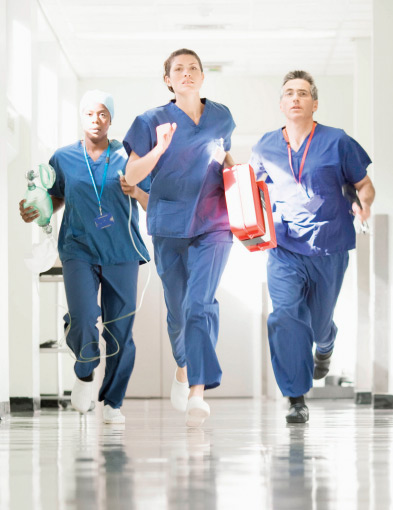SFC Safety Blog
10 Hospital Slip and Fall Risk Factors
It’s not only doctors, nurses, and medical personnel who face these risks; hospitals also employ maintenance staff, medical technicians, building and grounds staff, food service workers, laundry, housekeeping, and administrative personnel.
We’ve identified 10 slip hazards that hospital workers will likely encounter in this most challenging of work environments:

#1: Contaminated Floors
Wet floors, including floors contaminated with water, grease or food, are the most common cause of slip, trip and fall claims, according to the CDC. In a hospital environment, a host of other contaminants potentially come into play. In addition to being a slip hazard, continually wet surfaces promote the growth of mold, fungi, and bacteria that can cause infections. Keep floors dry and properly cleaned, and make it a policy to deal with spills immediately.
#2: Improper Footwear
Hospital workers need the right shoes to stay safe. Slip and fall incidents are dramatically reduced when employers mandate the use of slip-resistant safety footwear in the workplace. Wearing water-resistant, slip-resistant work shoes has been proven to decrease the likelihood of slip and fall accidents.
#3: Lack of Signage
It’s vital to alert employees and visitors to be careful and avoid contaminated, wet, or otherwise dangerous areas. Prevent entry into wet or slippery floor areas with highly visible warning signs— including barrier devices, placards or cones to redirect foot traffic—and always remove the signage once the area is safe and dry.
#4: Ineffective Floor Mats & Runners
Mats are only effective if properly used and maintained. Old or poorly placed mats can make your slip, trip, and fall problem even worse. Only use well-constructed commercial safety mats with a slip-resistant, high-traction rubber base that grips the floor and also provides traction on the surface. Place mats down on a clean, dry surface.
 #5: Stairs and Landings
#5: Stairs and Landings
Falling on stairs can result in some of the most serious slip and fall injuries, depending upon how steep or shallow the steps are. Make sure the area is well lit, and instruct workers to use the handrail when using stairs, to avoid rushing, and to be mindful of where they’re headed.
#6: Incorrect Housekeeping Protocols
Untrained hospital cleaning crews can do as much harm as good by using improper cleaning methods or cleaning solutions that leave floors wet, slick or slippery instead of clean and dry. Optimal floor cleaning procedures may help prevent slips and falls—for example, using no-skid waxes and cleaners, dry mopping following a wet mopping, etc. It’s the employer’s responsibility to make sure that every cleaner is properly trained.
#7: Clutter, Cords and Obstructions
Cluttered and crowded walkways and hallways are tripping hazards in any workplace, and hospitals have even more movable equipment and potential obstructions than most. Aisles and passageways should be sufficiently wide for easy movement and should be kept clear. Access to exits must remain clear of obstructions at all times. Temporary electrical cords that cross aisles should be taped or anchored to the floor. Use retractable cords whenever possible.
#8: Uneven Walking Surfaces
Though efforts should be made to install even, non-slip flooring or to treat existing floors with gritty, non-skid coatings, this is not always possible. Older buildings often have flooring that’s damaged, warped or buckled, with irregular surfaces or unexpected slopes, level changes or surface changes. (For example, walking from a carpeted floor to a tile floor can cause a pedestrian to trip.) If eliminating uneven surfaces is not feasible, these hazardous areas should be emphasized with signage or by painting levels in a contrasting color to differentiate.
#9: Inadequate Lighting
Poor visibility leads to accidents. Dim lighting keeps workers from fully seeing their surroundings and recognizing unsafe conditions in time to avoid them. Install more light fixtures in poorly lit areas. Verify light bulbs have an appropriate brightness and make sure they’re checked and replaced on a regular basis. Install fixtures that emit light from all sides.
#10: Food Service Areas & Restrooms
Sections of the hospital where food is prepared and served, as well as restroom facilities, are also considered high-risk areas. Wherever water, food or beverages can drip or spill onto the floor— kitchens, cafeterias, buffet lines, ice machines, freezers, dishwashers, sinks, soap dispensers, drinking fountains—should be given extra attention when formulating a slip-and-fall risk reducing plan. To keep the workforce safe, hospitals and all employers are required to comply with OSHA regulations designed to eliminate these slip, trip and fall hazards. Being aware of these major risk factors is a step in the right direction. Review your company’s comprehensive safety plan and make sure you’ve covered all the bases.
This information is for illustrative purposes only and is not meant to be a substitute for, or a legal interpretation of, occupational safety and health standards. Please refer to the appropriate state and federal codes of regulations for detailed and exact information, specifications, and exceptions.
SOURCES USED FOR THIS ARTICLE:
Wetmore, Chris (August 22, 2014) Avoiding Slip and Fall Accidents in Healthcare Facilities. Special to Healthcare Facilities Today. Retrieved from: https://www.healthcarefacilitiestoday.com/posts/details.aspx?id=6425
Healthcare-Wide Hazards. Retrieved from: https://www.osha.gov/SLTC/etools/hospital/hazards/slips/slips.html https://www.osha.gov/dsg/hospitals/documents/1.2_Factbook_508.pdf
5 Common Hazards Found in Hospital Environments. Retrieved from: https://www.premedlife.com/online-exclusives/5-common-hazards-found-in-hospital-environments-3372/
Slips: What You Need To Do. Retrieved from: http://www.hse.gov.uk/healthservices/slips/what-you-need-to-do.htm
Evaluation of a comprehensive slip, trip, and fall prevention program for hospital employees. Abstract retrieved from: https://www.cdc.gov/niosh/nioshtic-2/20035742.html Bell, Dr. Jennifer et al.
Slip, Trip and Fall Prevention for Healthcare Workers. Department of Health and Human Services. Centers for Disease Control and Prevention. Retrieved from: https://www.cdc.gov/niosh/docs/2011-123/pdfs/2011-123.pdf
To download a copy of this article to share please click here.
